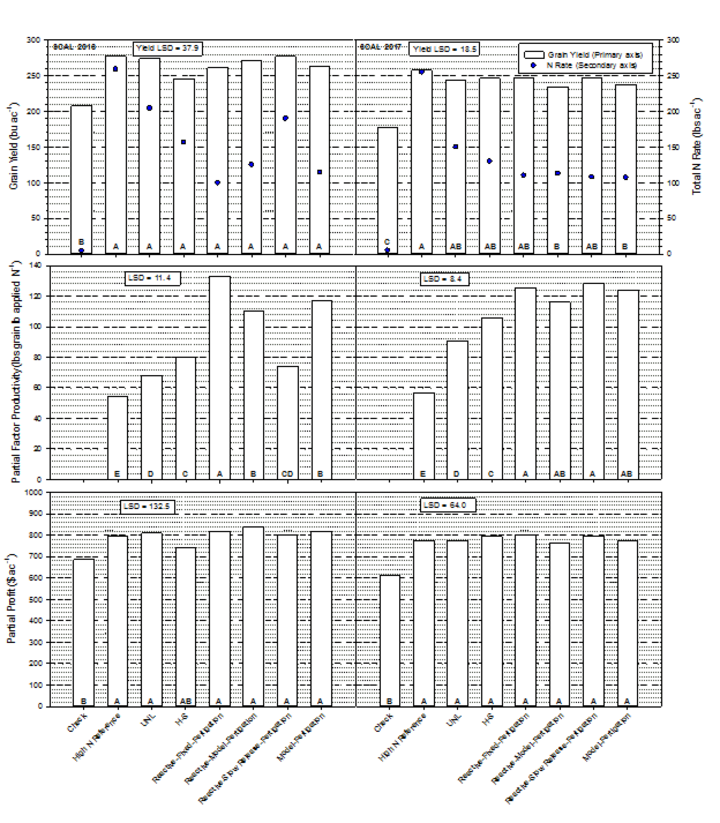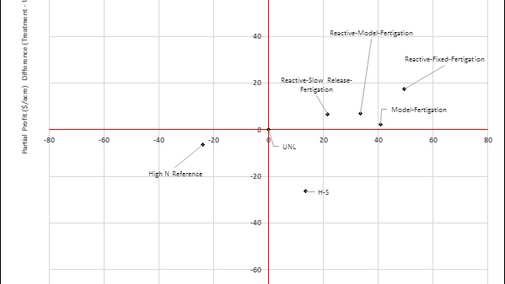Averaged across two years, the sensor-based N fertigation treatment consistently resulted in higher profit and nitrogen use efficiency. The use of fertigation offers the unique capability to minimize N losses by reacting to slight N deficiencies in corn by applying N multiple times throughout the season with lower application rates.
Methods
- Treatments:
- Check (5 lbs of N/acre as starter only)
- High N Reference (non-N limiting treatment)
- UNL algorithm (current N rate BMP, one time in-season sidedress informed by yield goal and N credits)
- Holland-Schepers (H-S) (sensor-BMP similar to Project SENSE, one time in-season sidedress directed by sensors) (Holland and Schepers, 2010)
- Reactive-fixed fertigation (fertigation directed by sensors: react to deficiency, N rate fertigated is fixed)
- Reactive-model fertigation (fertigation directed by sensors: react to deficiency, N rate fertigated is determined by crop computer model)
- Slow release reactive-model fertigation (initial N applied as polymer coated urea (slow release), fertigation directed by sensors: react to deficiency, N rate fertigated is determined by crop computer model)
 Figure 1: Comparison of the difference of each treatment versus. the UNL treatment (Treatment – UNL) for partial profit and nitrogen use efficiency. Data for each treatment was averaged across years 2016 and 2017 for the South Central Agricultural Laboratory (SCAL) near Clay Center. Partial profit was calculated using grain prices and N costs specific to each year: Partial Profit = (grain price * grain yield) – (N price * N applied). Treatments in the upper right quandrant indicate values that are more profitable and more N efficient when compared to the UNL algorithm treatment.
Figure 1: Comparison of the difference of each treatment versus. the UNL treatment (Treatment – UNL) for partial profit and nitrogen use efficiency. Data for each treatment was averaged across years 2016 and 2017 for the South Central Agricultural Laboratory (SCAL) near Clay Center. Partial profit was calculated using grain prices and N costs specific to each year: Partial Profit = (grain price * grain yield) – (N price * N applied). Treatments in the upper right quandrant indicate values that are more profitable and more N efficient when compared to the UNL algorithm treatment.
- Model-fertigation (not sensor informed, proactive N management is informed by crop model)
- All but Check received an initial base rate of N to maintain N sufficiency until sensors become reliably effective at V8.
- N was applied as UAN with exception of the slow release treatment that received slow release nitrogen as the initial base rate.
- Sensor-based methods use sufficiency index (SI) to indicate level of N stress.
- Research was conducted in 2016 and 2017 at the South Central Ag Lab near Clay Center under sprinkler irrigation/fertigation
Results
- Reactive-fixed fertigation treatment grain yield was not significantly different from that of the High N reference, but used considerably less nitrogen in both site years.
- The one time in-season sidedress application treatments (UNL, H-S) recommended more N compared to reactive-fixed fertigation treatment, but no accompanying gain in grain yield.
- Nitrogen use efficiency (NUE) reported as partial factor productivity (PFP) was highest for the reactive fixed fertigation treatment in both site years.
- Partial profit varied slightly by year. There was no significant difference between the treatment with highest partial profit and that of the reactive fixed fertigation treatment in both site years.
- Averaged across both years, the reactive-fixed fertigation treatment consistently resulted in higher profit and nitrogen use efficiency.
Closing/Summary
- There was no evidence to suggest use of 0.95 SI as the threshold for application was detrimental to yield.
- In 2016 and 2017 at location SCAL, the sensor-guided reactive-fixed fertigation treatment:
- Had the highest nitrogen use efficiency (partial factor productivity)
- Was among the highest yielding treatments (not significantly lower than any other)
- Had the highest partial profit
- Sensor-based fertigation shows potential to be a new BMP that increases nitrogen use efficiency while maintaining or increasing profit
 Figure 2: (Top) Grain yield and applied N rate, (Middle) partial factor productivity, a measure of nitrogen use efficiency (NUE), and (Bottom) partial profit for 2016 and 2017 at location SCAL. An alpha level of 0.05 was used for LSD mean comparison and is reported on each respective chart. Treatments with the same letter are not significantly different. Partial profit was calculated using grain prices and N costs specific to each year.
Figure 2: (Top) Grain yield and applied N rate, (Middle) partial factor productivity, a measure of nitrogen use efficiency (NUE), and (Bottom) partial profit for 2016 and 2017 at location SCAL. An alpha level of 0.05 was used for LSD mean comparison and is reported on each respective chart. Treatments with the same letter are not significantly different. Partial profit was calculated using grain prices and N costs specific to each year.
- Check (5 lbs of N/acre as starter only)
- High N Reference (non-N limiting treatment)
- UNL algorithm (current N rate BMP, one time in-season sidedress informed by yield goal and N credits)
- Holland-Schepers (H-S) (sensor-BMP similar to Project SENSE, one time in-season sidedress directed by sensors) (Holland and Schepers, 2010)
- Reactive-fixed fertigation (fertigation directed by sensors: react to deficiency, N rate fertigated is fixed)
- Reactive-model fertigation (fertigation directed by sensors: react to deficiency, N rate fertigated is determined by crop computer model)
- Slow release reactive-model fertigation (initial N applied as polymer coated urea (slow release), fertigation directed by sensors: react to deficiency, N rate fertigated is determined by crop computer model)

- Reactive-fixed fertigation treatment grain yield was not significantly different from that of the High N reference, but used considerably less nitrogen in both site years.
- The one time in-season sidedress application treatments (UNL, H-S) recommended more N compared to reactive-fixed fertigation treatment, but no accompanying gain in grain yield.
- Nitrogen use efficiency (NUE) reported as partial factor productivity (PFP) was highest for the reactive fixed fertigation treatment in both site years.
- Partial profit varied slightly by year. There was no significant difference between the treatment with highest partial profit and that of the reactive fixed fertigation treatment in both site years.
- Averaged across both years, the reactive-fixed fertigation treatment consistently resulted in higher profit and nitrogen use efficiency.
Closing/Summary
- There was no evidence to suggest use of 0.95 SI as the threshold for application was detrimental to yield.
- In 2016 and 2017 at location SCAL, the sensor-guided reactive-fixed fertigation treatment:
- Had the highest nitrogen use efficiency (partial factor productivity)
- Was among the highest yielding treatments (not significantly lower than any other)
- Had the highest partial profit
- Sensor-based fertigation shows potential to be a new BMP that increases nitrogen use efficiency while maintaining or increasing profit
- Had the highest nitrogen use efficiency (partial factor productivity)
- Was among the highest yielding treatments (not significantly lower than any other)
- Had the highest partial profit
- Sensor-based fertigation shows potential to be a new BMP that increases nitrogen use efficiency while maintaining or increasing profit


